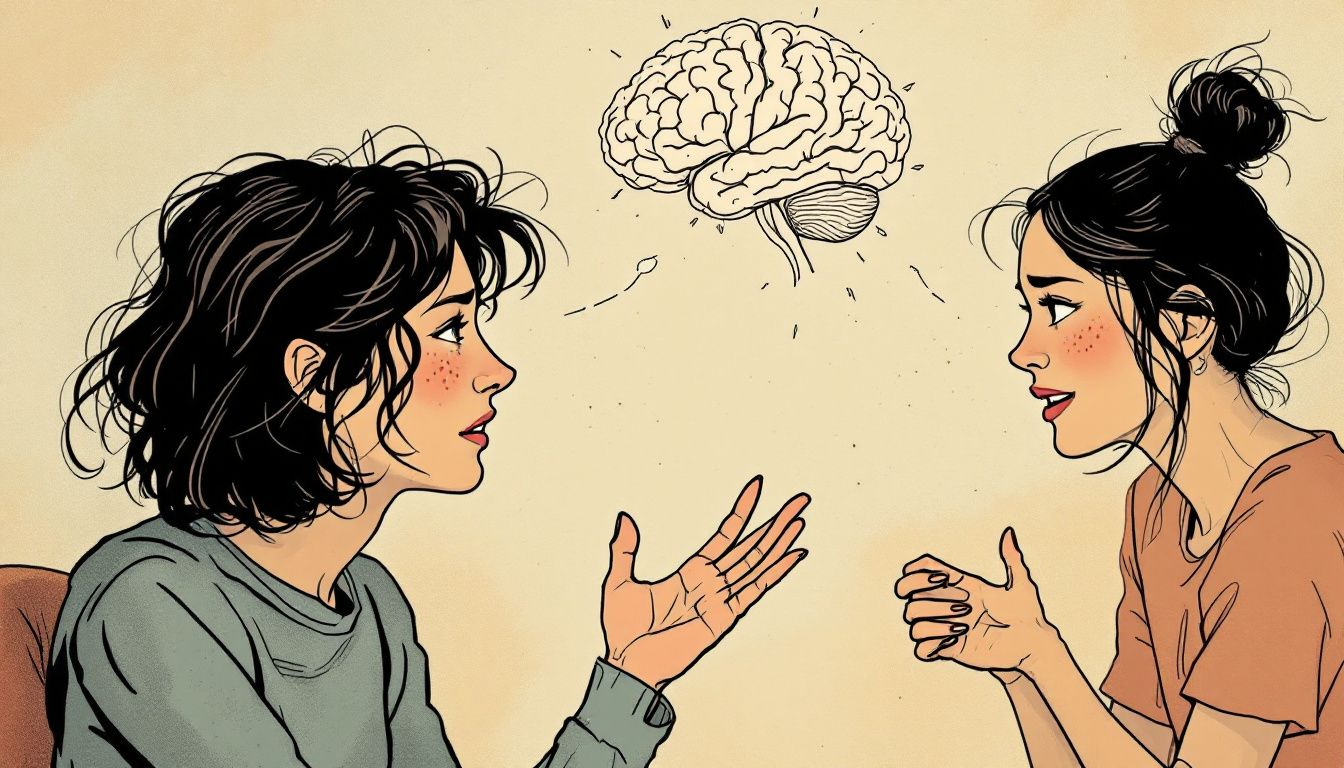Comprehensive Guide to Dyspraxia in Adults: Symptoms, Diagnosis & Management
Struggling with coordination and daily tasks? Dyspraxia in adults affects motor skills and organization, making activities like writing, cooking, and dressing difficult. Understand the symptoms, impacts, and management strategies in this comprehensive guide to help you improve your daily life.
Key Takeaways
Dyspraxia, a neurodevelopmental disorder, significantly impacts adults’ motor skills, affecting tasks requiring coordination and balance, leading to challenges in daily activities.
Diagnosis of dyspraxia in adults involves comprehensive assessments and the use of screening tools, with appropriate support crucial for effective management of the condition.
Therapies such as occupational, physical, and speech therapy, along with support networks and assistive technologies, play a vital role in enhancing the daily functioning and quality of life for individuals with dyspraxia.
Recognizing Dyspraxia in Adults
Dyspraxia is also known as developmental coordination disorder. It is a neurodevelopmental disorder that mainly impacts the coordination of motor skills. Adults with dyspraxia often experience significant challenges with balance, movement, and fine motor skills. These difficulties can manifest in various ways, from physical awkwardness to struggles with new motor skills, including what some refer to as clumsy child syndrome.
Common challenges for adults with dyspraxia include problems with fine motor skills, spatial awareness, and organization. Tasks that require precise movements, such as using utensils, writing, or typing, can be particularly challenging. This often leads to poor handwriting and difficulties in drawing or completing two-handed tasks. Additionally, personal care tasks like dressing and grooming can also present significant movement difficulties.
Recognizing dyspraxia symptoms is essential for obtaining the right help and support. Individuals suspecting dyspraxia should observe their symptoms and consult a general practitioner (GP) for an assessment. Understanding these symptoms can improve management and support.
Impact on Daily Life
Dyspraxia has a profound impact on various aspects of daily life. Routine tasks, such as dressing and meal preparation, can become increasingly challenging due to the varying symptoms of dyspraxia. Adults with dyspraxia often struggle with everyday tasks that require fine motor skills, such as cooking, writing, and typing.
Dyspraxia affects not only physical tasks but also emotional and mental health. Mood disorders such as depression and anxiety are frequent among those with dyspraxia, impacting their relationships and social functioning. Dyspraxia affect impaired organizational skills often cause difficulties in time management and planning.
A structured routine can significantly improve daily functioning for those with dyspraxia. Clear, step-by-step instructions and visual cues or reminders can ease anxiety and improve task completion. These strategies contribute to better daily task management and overall well-being.
Diagnosing Dyspraxia in Adults
Diagnosing dyspraxia in adults starts with a comprehensive assessment of motor skills and medical history. This evaluation identifies coordination difficulties and related symptoms. The Adult Developmental Coordination Disorders/Dyspraxia Checklist (ADC) serves as a preliminary screening tool.
In the United States, only medical doctors (MDs) and trained professionals can diagnose dyspraxia diagnosed. Suspecting adults should consult their general practitioner (GP) or a specialist for further evaluation. Accurate diagnosis is key to accessing appropriate support and management strategies.
The diagnostic process may include medical tests to rule out other conditions and confirm dyspraxia. Accurate diagnosis allows individuals to seek therapeutic interventions, improving their quality of life and helping them manage dyspraxia challenges.
Treatment and Management Strategies
Managing dyspraxia requires a mix of therapies and strategies to improve motor skills and daily functioning. Occupational therapy helps individuals develop self-care skills, promoting autonomy. Physical therapy enhances muscle tone and balance, improving coordination.
Speech therapy aids individuals with dyspraxia in enhancing speech clarity and language skills. Multisensory learning approaches can improve memory retention and task execution. These therapies form a comprehensive treatment plan tailored to individual needs.
Regular physical activity and exercises to improve gross motor skills can be beneficial. These interventions help individuals with dyspraxia manage their condition more effectively and enhance their ability to perform daily tasks independently.
Overcoming Challenges
Living with dyspraxia involves overcoming numerous challenges affecting various life aspects. Adults with dyspraxia often experience low self-esteem due to coordination challenges and physical difficulties. Emotional sensitivity can lead to heightened anxiety and feelings of inadequacy, impacting mental health.
Therapies help adults with dyspraxia manage everyday challenges and enhance independence. Focusing on strengths and unique talents allows individuals to contribute meaningfully in various fields, significantly improving self-esteem and overall well-being.
Effective coping strategies and support from therapists, family, and friends can significantly improve the lives of those with dyspraxia. Emphasizing strengths over limitations leads to a more fulfilling and empowered life.
Co-occurring Conditions
Dyspraxia often coexists with other conditions, complicating management. Common co-occurring conditions include ADHD, dyslexia, and anxiety disorders. These challenges impact cognitive functions like learning, memory, and emotional regulation, affecting overall well-being.
Dyspraxia can coexist with autism spectrum disorder and other learning difficulties, influencing social interactions and daily functioning. Secondary symptoms in adults with developmental coordination disorder (DCD) include depressed mood, addictions, and anxiety, further complicating overall health.
Recognizing these co-occurring conditions is crucial for developing a comprehensive management plan addressing all aspects of health. Integrated therapeutic approaches can manage these challenges and improve overall quality of life.
The Role of Therapy in Managing Dyspraxia
Therapy is vital in managing dyspraxia and improving quality of life. Speech therapy, occupational therapy, and physical therapy help adults develop essential skills and enhance daily functioning by targeting specific difficulties like motor skills, coordination, and speech.
Cognitive behavioral therapy (CBT) helps individuals cope with psychological challenges posed by dyspraxia. CBT empowers them to shift thought patterns and develop coping strategies to alleviate anxiety, improve emotional regulation, and enhance cognitive skills.
Occupational therapists help individuals develop practical skills and strategies for managing daily tasks and improving independence. These combined therapeutic approaches significantly improve the lives of adults with dyspraxia, aiding in better condition management and goal achievement.
Support and Resources
Support networks and resources are essential for individuals with dyspraxia. Online communities and support groups offer social connections and valuable resources for better condition management. Participating in events like Dyspraxia Awareness Week helps build connections and offers coping strategies.
Assistive technologies like dictation software enhance independence and productivity for adults with dyspraxia. These tools help organize thoughts and manage daily activities more efficiently, improving quality of life.
Educating friends and family about dyspraxia fosters a more inclusive environment for affected individuals. Awareness initiatives educate the public about the challenges faced by adults with dyspraxia, promoting greater understanding and support.
Long-term Outlook
Dyspraxia is a lifelong condition with ongoing challenges in memory, judgment, perception, and information processing, leading to difficulty learning. Despite these challenges, individuals can lead fulfilling lives with effective coping strategies and appropriate support. Positive feedback and reinforcement of achievements enhance self-esteem and motivation.
Leveraging unique strengths and talents allows adults with dyspraxia to succeed in various fields and contribute meaningfully to society. Increased public awareness and understanding can drive research into dyspraxia’s long-term effects and lead to more effective interventions.
Living with dyspraxia requires ongoing adjustments and support, but with the right strategies, individuals can achieve their goals and maintain a high quality of life.
Raising Awareness and Reducing Stigma
Raising awareness about dyspraxia is crucial for creating an inclusive society that accommodates affected individuals’ needs. Increased understanding of dyspraxia in adults has led to calls for more research and support. Awareness efforts aim to educate the public and reduce stigma, promoting a more understanding and supportive environment.
Books and resources like ‘Knowing No Boundaries’ and ‘Caged in Chaos’ offer insights and practical guidance for living with dyspraxia. Organizations such as the Dyspraxia Foundation work tirelessly to support individuals with dyspraxia and advocate for their needs.
Stigma and misconceptions are common issues for individuals with dyspraxia. Raising awareness and educating the public can reduce these negative perceptions and create a more inclusive society.
Summary
This comprehensive guide has explored the various aspects of dyspraxia in adults, from recognizing the symptoms to understanding the impact on daily life. We have discussed the importance of accurate diagnosis, effective management strategies, and the role of various therapies in improving quality of life. The significance of support networks and resources has also been highlighted.
By raising awareness and reducing stigma, we can create a more inclusive society that supports individuals with dyspraxia. With the right strategies and support, adults with dyspraxia can lead fulfilling lives and achieve their personal and professional goals.
Common signs of dyspraxia in adults include difficulties with coordination, fine motor skills, balance, and executing tasks that require precise movements, such as writing and typing. These challenges can significantly impact daily activities and personal care routines.
Dyspraxia in adults is diagnosed through an assessment of motor skills and a review of medical history, typically utilizing the Adult Developmental Coordination Disorders/Dyspraxia Checklist as a preliminary screening tool. Consultation with a medical professional is crucial for an accurate diagnosis.
Effective therapies for managing dyspraxia include occupational therapy, physical therapy, and speech therapy, as well as cognitive behavioral therapy for psychological support. Additionally, multisensory learning approaches enhance memory retention and task execution.
Dyspraxia significantly impacts daily life by complicating routine tasks such as dressing, cooking, and writing, while also contributing to emotional and mental health issues, including mood disorders and social interaction difficulties. Managing these challenges requires understanding and support.
Adults with dyspraxia can access support networks, online communities, and assistive technologies, which are essential resources for managing their condition. Engaging in awareness events, such as Dyspraxia Awareness Week, alongside educating family and friends, further enhances the support system.














